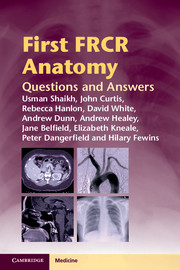Examination 5
Published online by Cambridge University Press: 05 March 2012
Summary
AP radiograph left knee
Popliteus tendon. This point represents the popliteal groove or sulcus within which the popliteus tendon inserts. The popliteus tendon is an important structure that contributes to stability of the postero-lateral corner of the knee.
Styloid process of the fibular head. Biceps femoris, a powerful hamstring muscle, attaches here along with the fibular collateral ligament and the arcuate ligament complex. The fibular styloid process can be avulsed during high energy trauma to the postero-lateral corner of the knee producing an ‘arcuate sign’ on radiographs.
Medial collateral ligament (MCL). The MCL is an important medial stabilizer of the knee, resisting valgus stress. A bony avulsion of the proximal MCL attachment may produce a non-united fragment called a Pellegrini–Stieda lesion, visible on AP radiographs.
Medial tibial spine. The medial tibial spine bears the attachment of the medial meniscal roots along with the footprint of the antero-medial bundle of the anterior cruciate ligament.
Bipartite patella. A bipartite patella is an unfused secondary ossification centre on the supero-lateral corner of the patella. These must not be mistaken for acute fractures, but may become symptomatic if the synchondrosis between the two bone fragments is disrupted following direct trauma.
Sialogram
Main submandibular duct. This is also known as Wharton's duct, and conveys mixed mucinous and serous secretions, which are more prone to form opaque calculi.
Intraglandular duct. On ultrasound scan examination, intraglandular ducts are visualized as small linear hypoechoic stripes.
Hyoid bone. This does not articulate with any other bone, and is held in position by the thyroid ligaments. It is highly mobile, with mobility provided by a number of muscles and ligaments. It develops from the second and third pharyngeal arches.
Condylar process of the mandible. The lateral extremity of the condyle is a small tubercle for the attachment of the temporomandibular ligament.
Coronoid process of the mandible. This is a thin triangular eminence, whose lateral surface affords insertion to the temporalis and masseter muscles.
- Type
- Chapter
- Information
- First FRCR AnatomyQuestions and Answers, pp. 133 - 140Publisher: Cambridge University PressPrint publication year: 2012



